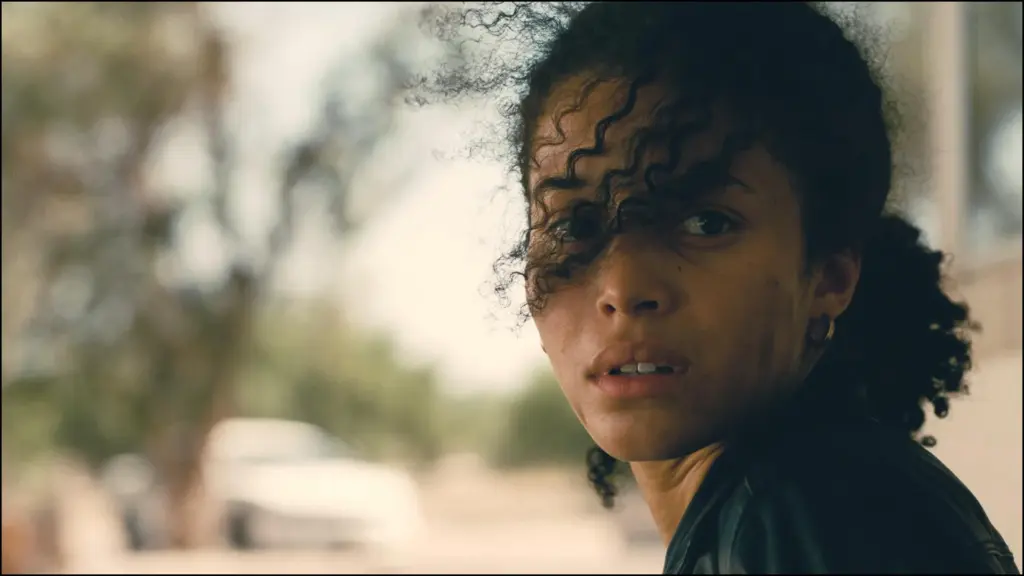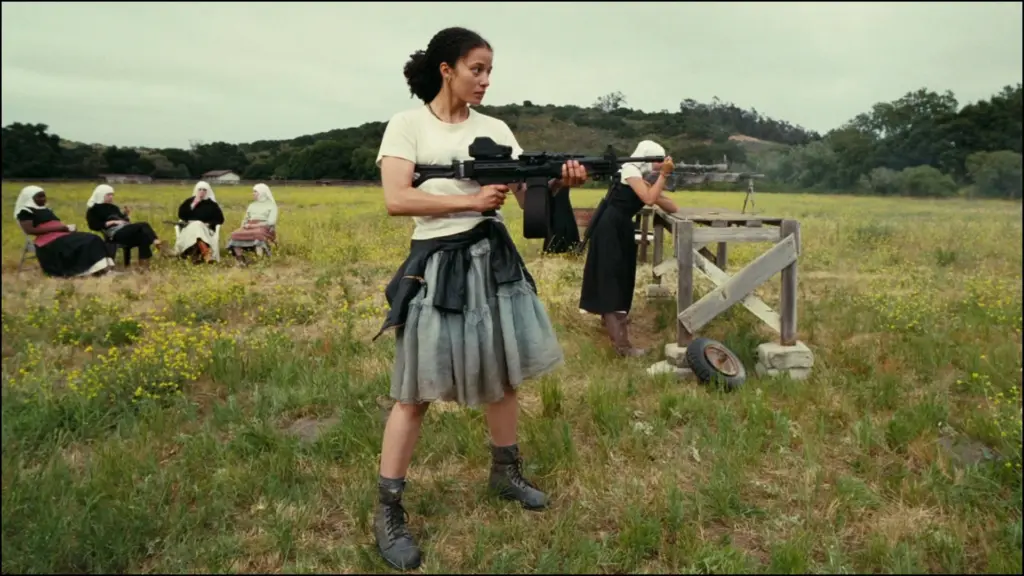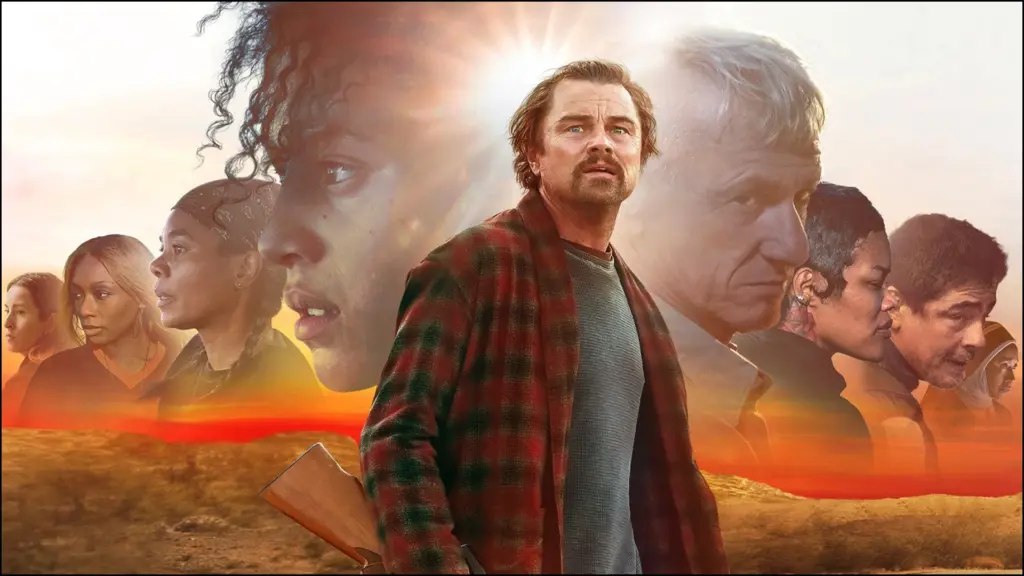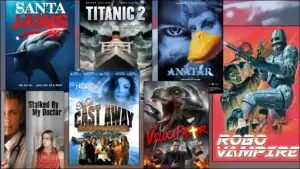In his wild new political thriller One Battle After Another, celebrated auteur Paul Thomas Anderson delivers a totally different take on the action movie.
Progressing naturalistically, the film is exciting and funny, but not quippy or campy. Action is new territory for Anderson, better known for period dramas like There Will Be Blood, Phantom Thread, and Boogie Nights. The film’s visual aesthetic is not far from an action film you would have once found in a Blockbuster Video.
The narrative is straightforward as well. Despite a 16-year time jump, the plotting is strictly linear, no flashbacks. I found the long early prologue a bit bumpy, but once the main story gets going the movie becomes an extended chase sequence like Midnight Run. It’s literally one battle after another.
The tone is tense, and the music (by frequent Anderson collaborator Jonny Greenwood) is propulsive. At the same time, Anderson deploys his signature emphasis on deadpan humor performances. One Battle After Another is often hilarious, but it’s so straight-faced you might miss the comedy. Ridiculous names provide clues; a deadly serious scene takes place in a convent featuring weed-farming, Black militant nuns called the “The Sisters of the Brave Beaver.”
One Battle After Another is built from the stripped-down premise of Thomas Pynchon’s postmodern novel Vineland. A stoner single dad (Leonardo DiCaprio) and his teenage daughter (aptly named newcomer Chase Infiniti) must run from a menacing Army officer (Sean Penn, comically uptight). The officer has been searching for their family’s missing mother (Teyana Taylor) since she disappeared during the late-1960s, when she led a leftist militant group similar to the Weather Underground.
DiCaprio’s character, known both as “Ghetto Pat” Calhoun and, undercover, as Bob Ferguson, was formerly the explosives expert for the revolutionaries (dubbed the French 75). Despite his past as a genuine bomb-throwing anarchist type, Bob has become a schlub who spends his days smoking weed and generally doing nothing. If he liked to bowl, he’d basically be The Dude from The Big Lebowski — whose backstory similarly identifies him as a washed up radical. (Anderson connoisseurs may note that this is his second take on a Dude-like character after the director’s other Pynchon adaptation, Inherent Vice, with Joaquin Phoenix as a pothead private investigator.)

You’d think a story about a hippie revolutionary with a teen daughter would take place in the late ‘80s, when the Pynchon novel was written. But One Battle After Another is set in the present, making it unclear what Bob and his wife – the deliciously named Perfidia Beverly Hills – were protesting 16 years ago, around 2009. The Iraq War and adjacent “war on terror”? The Occupy Wall Street movement? As galvanizing as these were for anti-war leftists, protests were non-violent. Despite the Trump Administration’s ongoing attempts to turn Antifa or Black Lives Matter into leftist bogeymen, there haven’t been any Weather Underground-style revolutionary bombings since the ‘70s.
So, while this is Anderson’s first movie in over two decades to be set in the present, and while the Pynchonian antifascist themes feel relevant during Trump’s second term, these facts seem coincidental. Anderson had no way of knowing that immigration raids, for example, would become a potent image when he planned that aspect of the story during the film’s initial production in 2023. And since the film is based on Pynchon’s specifically ‘80s premise – the aging of ‘60s radicals – it feels outside of time.
Perhaps the reason One Battle After Another registers as a comment on 2025 politics is that it’s such a universal story. The ongoing chase suggests the eternal struggle for liberation, and the family drama explores how to hand off your legacy (radical-left or otherwise) to your children. In the same way the 1975 Robert Altman film Nashville was a key influence of Anderson’s Boogie Nights, with this film it feels like Anderson is channeling Sidney Lumet’s Running on Empty. That 1988 gem has a similar premise about leftists trying to raise a family while on the run for revolutionary acts committed years earlier.
Like Running on Empty and Vineland, One Battle After Another also reflects on a father’s desire to protect his children from the instability of his past. DiCaprio’s Bob is fiercely protective of his daughter Willa, yet he has become politically complacent. He just wants to live his quiet life. When the French 75’s old nemesis Col. Steven Lockjaw (again with the deadpan-delivered silly names) shows up full of Sean Penn-style piss and vinegar, Bob is caught off-guard. He thought society had moved on from overt fascism. (Same here, Bob. Same here.)

Along the way Bob gets help from Sensei Sergio (Benicio del Toro), Willa’s karate teacher, who secretly runs what he calls a “Harriet Tubman situation”: a makeshift underground railroad for undocumented immigrants. The aforementioned Sisters of the Brave Beaver get involved too. These groups form a beautiful, aspirational image of a resistance network with secret cells operating both independently and cooperatively. Sure, it’s a fantasy world, and these revolutionaries are far more organized than even the groups in Star Wars or Andor. But what families wouldn’t want to raise their children in such a supportive village? (Well, one group might not.)
One Battle After Another envisions a multicultural world where people of every race and ethnicity join together, with fantastic competence, in the fight for justice and liberation. The Brave Beavers are Black, the Sensei’s network is Chicano, and practically every romantic relationship in the film is interracial. It’s a MAGA nightmare, complete with their ultimate boogeyman: miscegenation. Paul Thomas Anderson, father of four mixed-race children with his half-Black, half-Jewish wife, builds One Battle After Another into convincing treatise about why the Revolution is worth fighting for.















